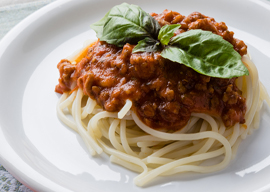
March 17, 2017

Source: Bigstock
The combination of Brexit and an imminent second Scottish independence referendum is profoundly depressing. Better to think of other things”food, for example. That offers comfort, even the possibility of jokes that aren”t sour. I find myself fondly remembering a distinguished poet who was amazed”and amused”to discover in his 60s that hamburgers were made of beef. He had till then associated them with the pig rather than the great Hanseatic city at the mouth of the Elbe. Actually, I”ve no idea”no doubt someone can tell me”whether burgers did indeed originate in Hamburg. Perhaps not. As a boy I was often taken to lunch at a hotel in Aberdeen where the menu offered “Vienna Steak,” in reality a bun-free hamburger. Perhaps Vienna was thought more classy than Hamburg. These Vienna steaks were anyway rather good, as I remember.
Here in Britain, as a welcome distraction from Brexit, there has been fierce argument about spaghetti Bolognese. It started when the cookery writer Mary Berry, who became a celebrity as the presenter of The Great British Bake Off on TV, published her recipe for it. “All wrong,” was the indignant cry, “scandalous.” She had committed what, in the eyes of some, was the cardinal sin of putting cream and white wine, rather than red, in her sauce. The rumpus was such that you might have thought she had insulted the Queen.
Well, of course, we all have strong views about food, about the correct, or at least the best, way of cooking or eating this or that. Take porridge, for instance. Some like brown sugar or golden syrup on it. Raw oatmeal sprinkled on top is better. Why? Because that’s how I ate it as a child. Some say porridge should always be eaten standing up and walking around, which is fine, but in the northeast of Scotland the practice used to be to have your milk or cream in a separate bowl, so that you enjoy the contrast of the cold milk and the hot porridge. All a matter of taste, but it’s certainly not easy to manipulate two bowls and a spoon while on your feet.
As for the Bolognese that has stirred people up, in Bologna itself, a city where you eat, or used to eat, better than anywhere else in Italy, it is simply known as “ragu,” which is the word that appears on menus, except in tourist restaurants, and means simply “sauce” or even “stew,” being the same word as the French “ragout.” It is made with chopped or minced beef, and yes, if wine is added, which isn”t always the case, the wine will probably be red.
Elsewhere in Italy the ingredients for a ragu may be different. In Naples, for instance, lamb is sometimes used instead of beef, and in Calabria, I”ve known it made with kid or goat. As for the wine, whatever was local, drawn from a barrel, would be used. In the Castelli outside Rome, that would usually be the white wine of Frascati or Marino. So to pretend that there is a fixed, immutable rule for the making of a ragu is daft.
Dishes devised by famous chefs may take a standard form if only because their inventor will probably at some point have printed the recipe, and then, clearly, if you choose to depart from this, you are not offering precisely the same dish. This doesn”t mean that you can”t quite reasonably offer variations on it. I would guess that most cooks who aren”t slaves to the authority of a cookbook do just that, on occasion anyway. It’s true that if you make too many changes, or use inadequate substitutes, you shouldn”t claim it’s the same dish. But if the result is pleasing, who cares? There’s always scope for invention, scope too for disagreement. This isn”t surprising.